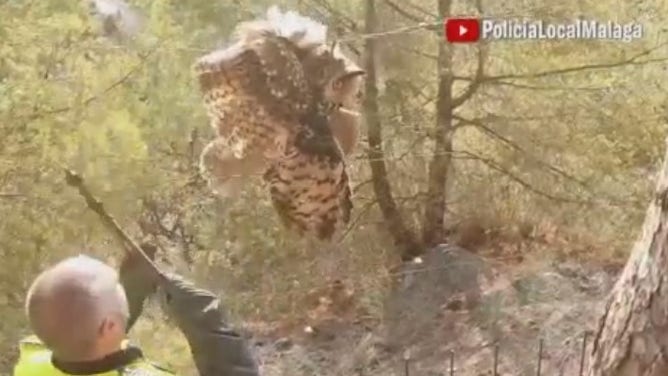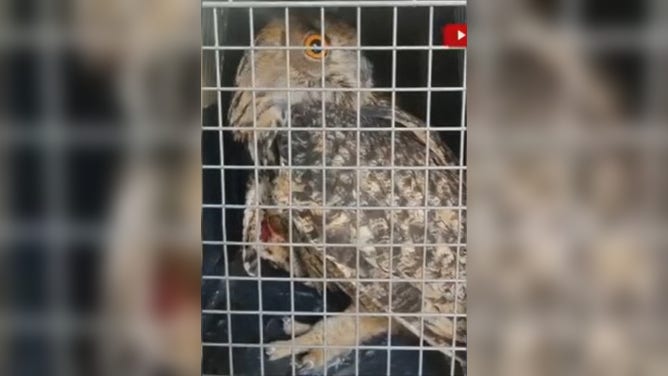Watch: Tense rescue of great horned owl tangled in barbed wire
Wildlife officers carefully free the owl from the barbed wire, trying not to injure it further.
Watch: Owl rescued from barbed wire
Wildlife officers in Malaga, Spain spend tense moments trying to pull a great horned owl off of barbed wire.
MALAGA, Spain – Watch and listen to tense video of wildlife officers trying to free an owl from barbed wire.
The terrified great horned owl shrieked as one officer approached. The cries sounded more like barks from a dog and became more high-pitched as the man started to move the wire to find out where the bird was caught.
The officer patiently clipped wire by wire with bolt cutters as the owl struggled. But, nothing freed the bird.

A great horned owl is tangled in barbed wire.
(Local Police of Malaga / FOX Weather)
"At first, the animal appeared scared and defensive, although it became more relaxed, allowing the agents to work," the Malaga Local Police reported on social media.
Two men carefully clipped more wires and tried to pull the body and wing from the entanglement. Unfortunately, one leg remained trapped.
Finally, one of the officers placed a large net under the distressed owl. The other officer cut another wire and the mass of feathers fell into the net. Several moments went by, and the bird did not move and remained unnaturally splayed out.

The bird fell into the net but took a while before trying to free itself and struggle.
(Local Police of Malaga / FOX Weather)
After one man grabbed a wing to apparently refold and place in the net, the bird squirmed for the first time. The rescue is far from over, however. The barbs dug deep into the one of the legs. The officers carefully cut the other side of the barbed wire from the fence. The bird is barely moving.
Police transferred the owl to a local animal refuge for immediate veterinary attention.
"A municipal veterinarian, with the help of other workers at the center, showed great skill in removing the pieces of wire that were embedded," the local police continued.

Blood stains wing and body feathers.
(Local Police of Malaga / FOX Weather)
Despite, pictures of the owl in a cage with a bloodied wing and leg, the Endangered Species Recovery Center of Malaga reported that it expects a complete recovery and to return the bird to its natural habitat.
A fun-fact about the great horned owl. Owls can't turn their heads all the way around in a complete circle, that is a myth, according to the Arizona-Sonora Desert Museum, the animals do have extra neck vertebrae and can turn heads almost 270 degrees. Turning heads is a must for survival because the species can not move its eyes.
